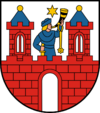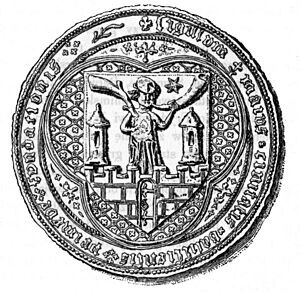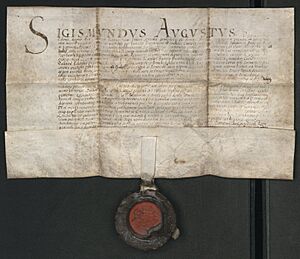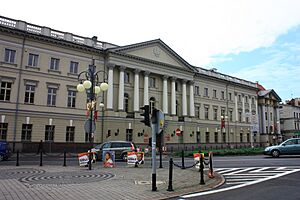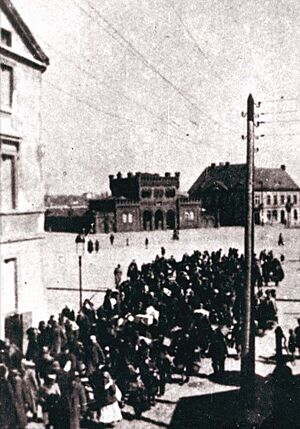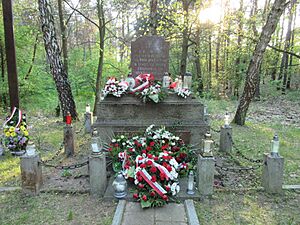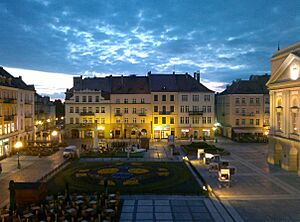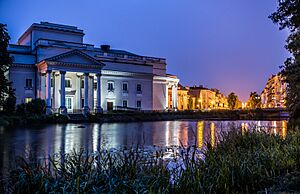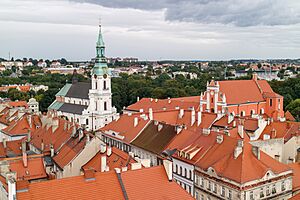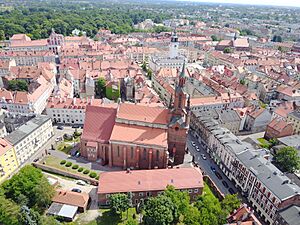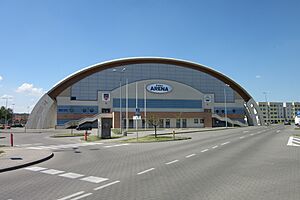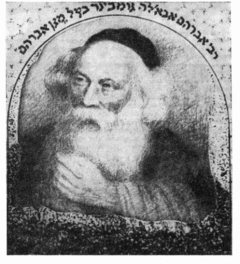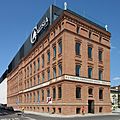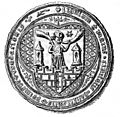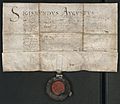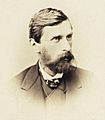Kalisz facts for kids
Quick facts for kids
Kalisz
|
|||
|---|---|---|---|
|
Top: Town Hall, Former "Calisia" Piano Factory
Middle: Courthouse, "Gołębnik" tenement Bottom: Aerial view of the Kalisz Old Town |
|||
|
|||
| Motto(s):
Latin: Poloniae urbs vetustissima (The oldest city of Poland)
|
|||
| Country | |||
| Voivodeship | |||
| County | city-county | ||
| Established | 9th century | ||
| Town rights | after 1268 | ||
| Area | |||
| • Total | 70 km2 (30 sq mi) | ||
| Population
(31 December 2021)
|
|||
| • Total | 97,905 |
||
| • Density | 1,472/km2 (3,810/sq mi) | ||
| Time zone | UTC+1 (CET) | ||
| • Summer (DST) | UTC+2 (CEST) | ||
| Postal code |
62-800 to 62-810
|
||
| Area code(s) | (+48) 62 | ||
| Car plates | PK, PA | ||
| Climate | Dfb | ||
| Website | www.kalisz.pl | ||
Kalisz (Polish: [ˈkaliʂ]) is a city in central Poland. It is the second-largest city in the Greater Poland Voivodeship. In December 2021, about 97,905 people lived there. Kalisz is the capital of the Kalisz Region. It is located on the Prosna river in southeastern Greater Poland. The city is connected with nearby towns like Ostrów Wielkopolski and Nowe Skalmierzyce.
Kalisz is one of the oldest cities in Poland. It is also one of the two traditional capitals of Greater Poland, along with Poznań. Since the Middle Ages, Kalisz has been an important regional center. It was a provincial capital and a notable royal city. Many Polish kings and dukes from the Piast dynasty were buried here. Kalisz has also been the site of important historical events and battles. Since the 1800s, it has been a center for industry. Today, it is a hub for culture, science, education, and administration in eastern and southern Greater Poland. It is also the main city for the Roman Catholic Diocese of Kalisz.
Contents
History of Kalisz
There are many old objects from Roman times found near Kalisz. These show that the area was once a stop for Roman traders. They traveled along the Amber Trail to the Baltic Sea. Some historians think the ancient city of Calisia, mentioned by Ptolemy in the 2nd century AD, might be Kalisz. However, others are not so sure.
Early Times and Middle Ages
Archaeologists have found signs of early settlements from the Piast dynasty period. These date back to the 9th to 12th centuries. Modern Kalisz was likely started in the 9th century. It began as a small fort and a local capital. Since it was part of the Greater Poland region, it has been part of Poland since the country began in the 10th century.
In 1106, Bolesław III Wrymouth took control of the town. He made it part of his land. Between 1253 and 1260, the town was given special rights. These rights were based on the Magdeburg Law, which helped towns grow. Kalisz became one of the richest towns in Greater Poland. During a time when Poland was divided, Kalisz became its own small duchy. It was ruled by a local branch of the Piast dynasty.
In 1264, the Statute of Kalisz was created in the city by Bolesław the Pious. This law gave special protection to Jews. At that time, Jews were often treated badly in Western Europe. This law made Poland a safe place for Jews to move to. After Poland was reunited, Kalisz became known for weaving and wood products. It was also an important cultural center in Greater Poland.
In 1282, Przemysł II of Poland confirmed the city's special laws. In 1314, King Ladislaus the Short made Kalisz the capital of the Kalisz Voivodeship. Kalisz was located in the middle of Poland at that time, making it a key trading center. In 1331, Polish forces successfully defended the city from a Teutonic Knight attack. Because of its important location, King Casimir III the Great signed a peace treaty with the Teutonic Order there in 1343. As a royal city, Kalisz kept many of its special rights. A new town hall was built in 1426. The Polish Duke Mieszko III the Old was buried in Kalisz.
From 1500 to the 19th Century
In 1574, the Jesuits came to Kalisz. In 1584, they opened a Jesuit College. This college became an important school in Poland. Around this time, Kalisz's importance started to decrease a little. The nearby city of Poznań became more important.
The economy of the area grew thanks to many Protestant Czech Brothers. They settled in Kalisz after being forced out of Bohemia in 1620.
In the 1700s, one of the main roads between Warsaw and Dresden went through Kalisz. Kings Augustus II the Strong and Augustus III of Poland often used this road. In 1792, a big fire destroyed much of the city center.
In 1793, during the Second Partition of Poland, the Kingdom of Prussia took control of Kalisz. The city was called Kalisch in German. In 1801, Wojciech Bogusławski started one of the first permanent theater groups in Kalisz.
In 1806, after a successful uprising, Poles regained Kalisz. It became a capital city in the short-lived Duchy of Warsaw. In 1813, the Treaty of Kalisz was signed here. This treaty confirmed that Prussia would now fight alongside Russia against Napoleon.
After Napoleon's defeat, Kalisz became a capital city in Congress Poland. Later, it became a province capital of the Russian Empire. The city's location near the Prussian border helped its economy grow. Many new people moved to Kalisz, not just from other parts of Poland and Russia, but also from German states. Fryderyk Chopin, a famous composer, visited Kalisz in 1826, 1828, and 1830. In 1835, Prussia and Russia held joint military exercises near the town. During the January Uprising in 1863, Polish fighters won two battles against the Russians near the city.
In 1902, a new railway line connected Kalisz to Warsaw and Łódź. Since the 1800s, Kalisz has been a major center for making pianos in Poland. By the early 1900s, it was the leading center, even more than Warsaw.
World War I and Between the Wars
When World War I started, Kalisz's location near the border caused big problems. It was one of the first cities to be destroyed in 1914. Between August 2 and 22, German forces shelled and then burned Kalisz to the ground. This happened even though Russian troops had left the city without fighting. Many German soldiers were ethnic Poles and were at first welcomed peacefully. Eight hundred men were arrested, and some were killed. The city was set on fire, and the remaining people were forced to leave. In 1914, about 68,000 people lived in Kalisz. A year later, only 5,000 remained. By the end of the war, much of the city center had been rebuilt. Many former residents were allowed to return.
After the war, Kalisz became part of the newly independent Poland. On December 13, 1918, a group of volunteers from Kalisz joined the Greater Poland uprising (1918–19) against Germany. The city continued to rebuild, and a new city hall opened in 1925. In 1939, Kalisz had about 81,000 people.
World War II
After Germany invaded Poland in September 1939, Kalisz's border location again caused disaster. The German army, the Wehrmacht, captured Kalisz after Polish resistance. The city was then taken over by Germany. To punish the resistance, the Wehrmacht carried out mass killings of Polish defenders. These executions happened in the city and in the nearby area of Winiary. Over 1,000 people were arrested. Many Poles were arrested and killed during the Intelligenzaktion. This was a plan to destroy Polish leaders and thinkers. About 750 Poles from Kalisz and nearby towns were held in the Kalisz prison from September 1939 to March 1940. Most of them were killed in large massacres in the Winiary forest. In November 1939, a Nazi killing squad, the Einsatzgruppe VI, murdered 41 Poles at the local Jewish cemetery. Among them was Ignacy Bujnicki, the pre-war mayor of Kalisz. In April and May 1940, many Poles arrested in the region, especially teachers, were sent to concentration camps. They were murdered in Mauthausen and Dachau.
In Kalisz, the Germans set up a camp for Polish children. These children were taken from their parents. They were given new German names and punished for speaking Polish. Some were even killed, like a 14-year-old boy named Zygmunt Światłowski. After leaving the camp, the children were sent to Germany. Only some returned to Poland after the war. The fate of many others is still unknown.
By the end of World War II, about 30,000 local Jews had been killed. Also, 20,000 local Catholics were either killed or forced to leave. They were sent to other parts of German-occupied Poland or to Germany as forced workers. In 1945, the city's population was 43,000. This was about half of what it was before the war. In 1945, Kalisz was returned to Poland.
After the war, Jewish Holocaust survivors returned to the city. By 1946, there were about 500. By the late 1940s, only about 100 remained. Those who stayed became part of Polish society.
From 1950 to Today
In 1975, Kalisz became the capital of a province again, the Kalisz Voivodeship. This province was removed in 1998. Since then, Kalisz has been the county seat of its own county within the Greater Poland Voivodeship. In 1976, the city grew larger. It took in nearby settlements like Majków and Szczypiorno as new districts. In August 1980, workers in local factories joined strikes across Poland. This led to the creation of the Solidarity organization. Solidarity played a big role in ending communist rule in Poland.
In 1991, the city started its annual festival on June 11. This day celebrates the confirmation of the city's rights in 1282. In 1992, Kalisz became the main city for a separate diocese of the Catholic Church. In 1997, Pope John Paul II visited Kalisz.
The city was once home to the 'Calisia' piano factory. It closed in 2007. The factory building was turned into the Calisia One Hotel, which opened in 2019.
Climate in Kalisz
Kalisz has an oceanic climate or a humid continental climate. This means it has warm summers and cold winters.
| Climate data for Kalisz (1991–2020 normals, extremes 1951–present) | |||||||||||||
|---|---|---|---|---|---|---|---|---|---|---|---|---|---|
| Month | Jan | Feb | Mar | Apr | May | Jun | Jul | Aug | Sep | Oct | Nov | Dec | Year |
| Record high °C (°F) | 13.8 (56.8) |
18.1 (64.6) |
22.7 (72.9) |
29.8 (85.6) |
31.4 (88.5) |
36.6 (97.9) |
36.9 (98.4) |
38.0 (100.4) |
35.1 (95.2) |
27.2 (81.0) |
19.3 (66.7) |
15.8 (60.4) |
38.0 (100.4) |
| Mean daily maximum °C (°F) | 1.7 (35.1) |
3.4 (38.1) |
7.8 (46.0) |
14.6 (58.3) |
19.4 (66.9) |
22.8 (73.0) |
25.2 (77.4) |
25.0 (77.0) |
19.4 (66.9) |
13.3 (55.9) |
7.2 (45.0) |
2.9 (37.2) |
13.6 (56.5) |
| Daily mean °C (°F) | −0.8 (30.6) |
0.3 (32.5) |
3.7 (38.7) |
9.4 (48.9) |
14.1 (57.4) |
17.3 (63.1) |
19.5 (67.1) |
19.3 (66.7) |
14.4 (57.9) |
9.2 (48.6) |
4.4 (39.9) |
0.6 (33.1) |
9.3 (48.7) |
| Mean daily minimum °C (°F) | −3.0 (26.6) |
−2.3 (27.9) |
0.3 (32.5) |
4.6 (40.3) |
9.0 (48.2) |
12.3 (54.1) |
14.2 (57.6) |
14.2 (57.6) |
10.1 (50.2) |
5.9 (42.6) |
2.1 (35.8) |
−1.6 (29.1) |
5.5 (41.9) |
| Record low °C (°F) | −28.5 (−19.3) |
−28.3 (−18.9) |
−21.1 (−6.0) |
−7.2 (19.0) |
−3.8 (25.2) |
2.4 (36.3) |
4.0 (39.2) |
4.8 (40.6) |
−1.7 (28.9) |
−7.4 (18.7) |
−16.6 (2.1) |
−25.1 (−13.2) |
−28.5 (−19.3) |
| Average precipitation mm (inches) | 26.4 (1.04) |
24.3 (0.96) |
33.2 (1.31) |
26.9 (1.06) |
53.0 (2.09) |
54.8 (2.16) |
77.3 (3.04) |
54.3 (2.14) |
46.0 (1.81) |
36.8 (1.45) |
31.0 (1.22) |
29.7 (1.17) |
493.8 (19.44) |
| Average extreme snow depth cm (inches) | 5.0 (2.0) |
4.2 (1.7) |
2.4 (0.9) |
0.8 (0.3) |
0.0 (0.0) |
0.0 (0.0) |
0.0 (0.0) |
0.0 (0.0) |
0.0 (0.0) |
0.2 (0.1) |
1.5 (0.6) |
3.6 (1.4) |
5.0 (2.0) |
| Average precipitation days (≥ 0.1 mm) | 15.17 | 13.33 | 13.00 | 10.47 | 12.50 | 13.00 | 13.40 | 11.70 | 10.87 | 12.43 | 13.13 | 15.13 | 154.13 |
| Average snowy days (≥ 0 cm) | 12.5 | 10.2 | 4.8 | 0.7 | 0.0 | 0.0 | 0.0 | 0.0 | 0.0 | 0.1 | 1.9 | 7.1 | 37.3 |
| Average relative humidity (%) | 87.9 | 84.7 | 79.3 | 71.1 | 72.5 | 72.9 | 71.9 | 71.2 | 78.2 | 84.3 | 89.4 | 89.4 | 79.4 |
| Mean monthly sunshine hours | 49.3 | 69.6 | 120.8 | 195.2 | 248.1 | 253.4 | 253.3 | 242.9 | 160.5 | 110.7 | 52.0 | 41.0 | 1,796.7 |
| Source 1: Institute of Meteorology and Water Management | |||||||||||||
| Source 2: Meteomodel.pl (records, relative humidity 1991–2020) | |||||||||||||
Kalisz Neighborhoods
Kalisz is divided into many different neighborhoods. Each one has its own unique feel. Here are some of the main areas:
| Name | Population | Area (km2) | Area (mi2) |
|---|---|---|---|
| Asnyka | 5697 | 0.44 | 0.1698849 |
| Chmielnik | 3612 | 3.28 | 1.266415 |
| Czaszki | 7130 | 0.67 | 0.2586884 |
| Dobro | 597 | 1.96 | 0.7567602 |
| Dobrzec | 867 | 8.62 | 3.328201 |
| Dobrzec P | 8599 | 1.51 | 0.5830143 |
| Dobrzec W | 5503 | 0.38 | 0.146719 |
| Kaliniec | 4685 | 0.36 | 0.1389968 |
| Korczak | 4459 | 0.73 | 0.281855 |
| Majków | 3311 | 2.96 | 1.142862 |
| Ogrody | 2073 | 2.06 | 0.7953704 |
| Piskorzewie | 1915 | 1.99 | 0.7683433 |
| Piwonice | 2660 | 8.72 | 3.366811 |
| Rajsków | 1884 | 3.43 | 1.32433 |
| Rogatka | 2720 | 0.27 | 0.1042476 |
| Rypinek | 3708 | 4.48 | 1.729738 |
| Sulisławice | 835 | 4.68 | 1.806958 |
| Sulisławice Kolonia | 164 | 1.19 | 0.4594616 |
| Szczypiorno | 1529 | 5.87 | 2.26642 |
| Śródmieście | 17258 | 1.76 | 0.6795398 |
| Tyniec | 4189 | 3.02 | 1.166029 |
| Widok | 6516 | 0.44 | 0.1698849 |
| Winiary | 2491 | 5.40 | 2.08495 |
| XXV-lecia | 5094 | 1.02 | 0.3938242 |
| Zagorzynek | 2773 | 3.89 | 1.501937 |
Religion in Kalisz
Kalisz has many places of worship. There are 19 Catholic churches, five Protestant churches, and one Eastern Orthodox church. The city is home to the Cathedral of St. Nicholas. Before World War II, there were about 25,000 Jewish people in Kalisz. Most of them were killed by Germans during the Holocaust in Poland. By the summer of 1942, the Jewish community in Kalisz was almost completely destroyed.
Education in Kalisz
Kalisz is an important center for education in its region. It has 29 primary schools and 15 junior high schools. There are also five high schools. The city is home to seven colleges and many vocational schools. Kalisz also has branches of Poznań University, Poznań University of Economics, and Poznań University of Technology. The Henryk Melcer Music School is also located here.
Economy of Kalisz
Kalisz has several large businesses, even though there isn't much heavy industry. It has food processing plants like Winiary (part of Nestlé) and Colian. There is also the Big Star jeans factory. Two factories that make airplane engines are in Kalisz: WSK-Kalisz and Pratt & Whitney Kalisz.
Local Cuisine
The Andruty kaliskie wafers are a famous traditional food from Kalisz. They are well-known throughout Poland.
Another special food from the area is homemade cold pressed fruit juices. These juices are made from fresh fruits grown in the Kalisz Region. They follow old recipes and have no extra ingredients. You can find juices made from apples, pears, cherries, blackcurrant, redcurrant, strawberries, and raspberries. This tradition of making juices goes back many centuries.
Sports in Kalisz
The district of Szczypiorno is famous for handball. It's where the first games of handball in Poland were played. That's why the Polish name for handball is szczypiorniak. Other popular sports in Kalisz include football and volleyball. Some notable sports teams are:
- MKS Kalisz – a men's handball team that plays in the top Polish league.
- SSK Calisia Kalisz – a women's volleyball team that plays in the top Polish league. They have won the Polish Championship four times.
- KKS Kalisz – a men's football team that plays in the Polish II liga.
Kalisz is also home to Kaliskie Towarzystwo Wioślarskie. This is one of the oldest Polish rowing clubs, started in 1894.
Transport in Kalisz
The Kalisz railway station was built in 1902. It was the end point of the Warsaw–Kalisz Railway. Today, it is served by Przewozy Regionalne and PKP Intercity trains.
What Does Kalisz Mean?
The name Kalisz is thought to come from an old word, kal. This word means swamp or marsh.
Famous People from Kalisz
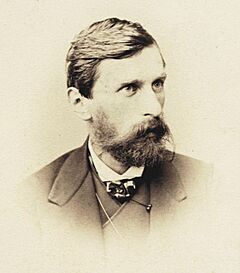
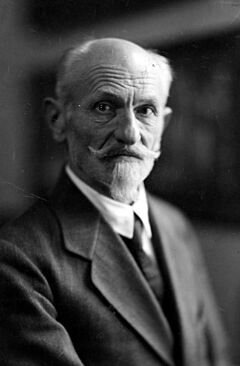
- Adam Asnyk (1838–1897), a poet.
- Wojciech Bogusławski (1757–1829), an actor and theater director.
- Bolesław the Pious (1224/27–1279), a duke of Greater Poland.
- Maria Dąbrowska (1889–1965), a writer.
- Janina David, born Janina Dawidowicz (1930–2023), a writer and Holocaust survivor.
- Agaton Giller (1831–1887), a Polish activist.
- Avraham Gombiner (1635–1682), a Jewish rabbi and scholar.
- Jerzy Kryszak (born 1950), an actor.
- Theodor Meron (born 1930), a judge.
- Alina Szapocznikow (1926–1973), a sculptor and Holocaust survivor.
- Marta Walczykiewicz (born 1987), an Olympic medalist in sprint canoeing.
- Stanisław Wojciechowski (1869–1953), a former president of Poland.
- Jan Ptaszyn Wróblewski (born 1936), a musician.
Kalisz's Sister Cities
Kalisz has friendly relationships with many cities around the world. These are called "twin towns" or "sister cities." They work together on cultural and educational projects.
|
|
Images for kids
-
Polish King Sigismund II Augustus confirms the old privileges of Kalisz, 1552
-
Adam Asnyk, a famous poet
-
Stanisław Wojciechowski, a former president of Poland
See also
 In Spanish: Kalisz para niños
In Spanish: Kalisz para niños








